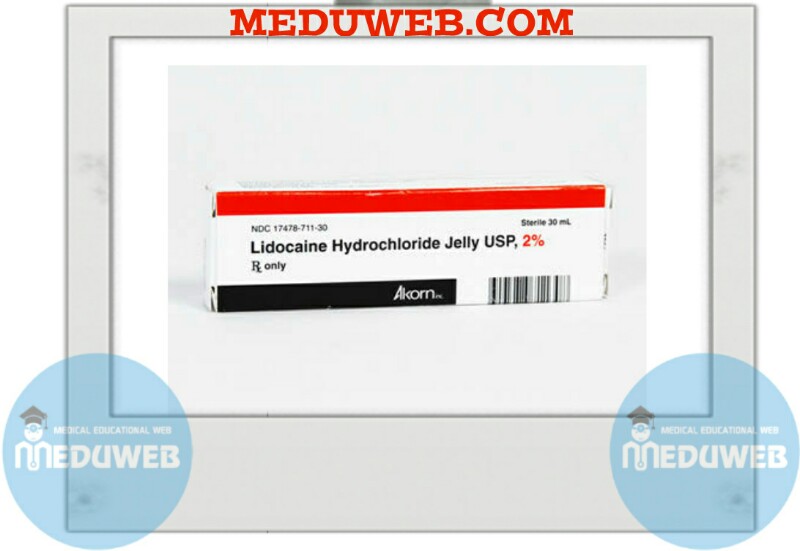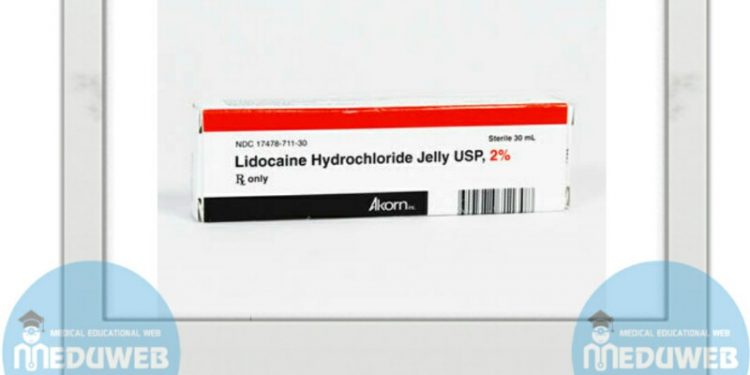Lidocaine Composition:
Each 100 gm contains:
Lidocaine hydrochloride 2.0 gm equivalent to Lidocaine base 1.62 gm
Lidocaine Properties :
Lidocaine is a safe and effective local anaesthetic for surface use . when applied locally ~ prevents the generation and conduction of nerve impulse , attering the permeability of ions , particularty the sodium influx through the cell membrane
It is usually effective within 5 minutes of application and has a duration of effect of 1-2 hours .

Lidocaine Indications & Usage:
ne can be used topically to give relief from local pain and I or itching due to :
– Mild bums and sun bums
-Insect bites
– Sore nipples and abrasions
– Pruritus ani and vulvae
– Anal fissures and haerrormoids
– ProcIosropy and sigmoidoscopy
-Stomatitis
– Herpetic lesions
Lidocaine Side effects :
Local adverse reactions are very rare with Lidocaine and include
allergic skin reaclions .
Lidocaine Dosage & Administration:
Apply to the affected areas as a thin film 1-2 times daily.
Lidocaine Packing:
Pack contains tube of 20 gm
Lidocaine Produced by :
alexandria co. for pharmaceuticals – alexandria – A.R.E
Lidocain PPT power point presentation :
1. THE GOLD STANDARD DRUG PRESENTED BYVANDITA SINGH
2. Lidocaine Lidocaine, the first amino amide-type local anesthetic, was first synthesized under the name Xylocaine by Swedish chemist Nils Löfgren in 1943. FDA Approved-November 1948
3. Indications Rapid acting local anesthetic for procedures ranging from infiltration to regional nerve block Antiarrhythmic in the treatment of vent. arrhythmias Treatment of status epilepticus (INVESTIGATIONAL) Treatment of pain Operative Neuropathic pain
4. Pharmacology Half life: 1.6 hrs(~90 min) Distribution: Lipo-philic, widely distributed into body pH of plain solution-6.5 pH of vasoconstrictor containing solution-5.0-5.5 Onset of action –rapid Pregnancy clissification-B Effective dental concentration-2% Protein binding: 60-80 %
5. MAXIMUM RECOMMENDED DOSE The max. manufactures recommended dose of lidocaine with epinephrine is 7.0mg/kg body weight for adult patient,not to exeed dose of 500mg. 4.4mg/kg body weight dose of lidocaine without a vasoconstrictor
6. ACTIONS ON CNS ON CVS (i) Blocks conduction around a nerve Heart Anaesthesia (ii) Initially causes drowsiness & lethargy (iii) Higher doses cause excitation followed by depression Abbreviates Effective Refractory Period Blood vessels Vasodilatation in the injected area
7. MECHANISM OF ACTION Alters depolarization in neurons by blocking the fast voltage gated sodium (Na+) channels in the cell membrane. With sufficient blockade, the membrane of the presynaptic neuron will not depolarize and so fail to transmit an action potential, leading to its anaesthetic effects
8. PHARMACOKINETICS Absorption: Absorbed rapidly after parenteral administration & from GIT & Respiratory Tract Metabolism: Metabolized in the liver Excretion: Metabolites and unchanged drug are excreted by the kidneys in the urine
9. ROUTES OF ADMINISTRATION Intravenous injection (sometimes combined with epinephrine) Dermal patch (sometimes combined with prilocaine) Nasal instillation/spray (combined with phenylephrine) Topical gel
10. DIFFERENT FORMS OF LIDOCAINE 2% WITHOUT VASOCONSTRICTOR (LIDOCAIN PLAIN) Its vasodilating effect limits pulpal anesthesia to only 5-10min. This leads to higher blood levels& increased risk of adverse reaction 2% WITH EPINEPHRINE 1:50,000 2% WITH EPINEPHRINE 1:100,000 The inclusion of epinephrine produces a decrease in blood flow leading to decrease in bleeding at the site of injection. Decreases blood flow . Increases duration of action~60min of pulpal anesthesia. Increased duration-~60min of pulpal anesthesia The duration &depth obtained with both lidocaine-epinephrine solution are equivalent although not the same level of hemostasis.{2%lidocaine with 1:50,000 epinephrine is recommended because it decrease bleeding by 50% as compared with 1:100,000 epinephrene dilution}
11. Intravenous Lidocaine for Ambulatory Anesthesia Christopher L. Wu, MD ,Inter Anes Research Society,Dec. 2009 Using 1.5–3 mg kg h lidocaine significantly reduced the incidence of nausea and vomiting (32% vs 52%), Marginally reduced pain scores .
12. ADVERSE EFFECTS
13. OVERDOSE
14. CONTRAINDICATIONS
15. EUTECTIC MIXTURE OF LOCAL ANESTHETICS (EMLA)- LIDOCAINE & PRILOCAINE Eutectic mixture refers to lowering of melting point of two solids when they are mixed Lidocaine+Prilocaine at 25oC Oil emulsified into water to form a cream
16. CLINICAL USES/ INDICATIONS Dermal anaesthesia, specifically applied to prevent pain associated with intravenous catheter insertion, blood sampling, superficial surgical procedures on intact skin & mucous membranes Topical anaesthesia for cleansing or debridement of ulcers, to numb the skin before tattooing as well as laser hair removal
Lidocaine


